We get a virtual truckload of E-mail around here, and lately have noticed a new phenomenon. Instead of readers asking us to help them choose between two different makes and models, more and more are trying to decide between two models from the same manufacturer. Sibling rivalry, as it were. Or as we've dubbed it for this issue: "Family Feud."
One of the most common brands cited was BMW. And two of the most common models were the K1300S and K1300GT. Which should you buy?
On the surface, that seems like a no-brainer. One is a sportbike, the other a sport-tourer. But given that a raft of touring amenities are available for the former, and that the latter shares the same sporty platform, the line blurs.
Look at the two parked nose to nose and the first thing you notice is that these are elegant motorcycles, their rakish styling devoid of tacky decals or graphics. Instead, in a nod worthy of a Bavarian sports car, the BMW roundel is inlaid on each side of the S-model's fairing, and perched atop stylish louvers on the GT.
Look beyond the bodywork, and you'll note that these two machines share the same architecture. Both are built on the same aluminum twin-spar frame with single-shock Duolever front and Paralever rear ends. They're shaft drive, naturally, with a single-sided swingarm on the left and a massive muffler on the right. The main difference is the GT's subframe is more substantial to support the additional weight of its standard luggage-not to mention your passenger.
Motive power comes from the same forward-inclined transverse inline-four (Beemerphiles call it a Slant/4) that debuted on the 1157cc K1200S, bored 1mm and stroked 5.3mm to displace 1293cc. With DOHC, Formula 1-style finger followers and liquid cooling, this is no shadetree mechanic's Boxer twin, but service intervals are fairly reasonable at 18,600 miles. And we've heard reports of some bikes going twice that far without needing their valves adjusted.
Swing a leg over the GT and you're sitting in the lap of luxury. The cockpit features two analog gauges: a 170-mph speedometer on the left and a tachometer that redlines at 10,000 rpm on the right. A central digital display shows everything imaginable, including ambient temperature, engine temp, average speed, miles per gallon and range. That same display includes a fuel gauge and a gear indicator, while on a panel above it warning lights illuminate to tell you when you're in neutral, when the high-beam is on or if the ABS needs to be reset ("Brake Failure," it reads alarmingly). You toggle between these functions with the Info button on the left bar cluster, and reset the dual tripmeters or the clock with the two buttons on the dash itself.
The S-model's dash is only slightly less complex, with the speedo and tach trading places and the LCD slid over to the right. Owing to its sportier state of tune (146.9 horsepower and 89.6 lb.-ft. of torque, compared to the GT's 135.4 bhp and 86.9 lb.-ft.), its speedo reads to 180 mph and its tach redlines at 11,000 rpm.
Both of our testbikes were equipped with what BMW calls its Premium Package. The GT gets a bright Xenon headlight, heated handgrips and seats, Electronic Suspension Adjustment (ESA II), Automatic Stability Control (ASC), Tire Pressure Monitor (TPM), Cruise Control and an On Board Computer, all of which takes the price from $19,150 to $22,595. The S gets heated grips, an electronic quick-shifter (called Gear Shift Assistant), ESA II, ASC and TPM, which takes the price from $15,550 to $17,800. The accessory expandable side cases (formally Sports Pannier System) on our S-model costs an additional grand.
These options add a few more functions to the dash, notably an ESA display controlled by another button on the left bar cluster. Push the button anytime to choose which damping setting you desire (Normal, Sport or Comfort), or hold it down at a standstill to select which preload setting you desire (indicated by one helmet, one helmet with luggage or two helmets). Add to that the switches for the GT's cruise control and electrically adjustable windscreen and it's no wonder the high beam is incorporated into the Euro-style passing button actuated by your left index finger. The oddest control of all might be the single turnsignal switch; gone are BMW's proprietary separate left- and right-side switches. Likewise the horn is now a regular pushbutton instead of mirroring the turnsignal cancellation button formerly actuated by lifting up your thumb.
With all of these bells and whistles, it's easy to feel overwhelmed at first. But spend a long day in the saddle (or six days, like we did), and it all starts to feel natural. Then you start to think about how these motorcycles actually work.
Off The Record
Paul Catterson, The Editor's Brother
Age: 43
Height: 6'2"'
Weight: 220 lbs.
Inseam: 34 in.
The first thing that surprised me about these two BMWs was the sheer power. The delivery felt less like a curve and more like a ramp: very linear. I spent most of my time between 3000 and 7000 rpm, and because the engine braking was so effective, I only needed to use the brakes in the twistiest twisties. What happens above 9000 rpm is a mystery to me!
The ESA made a huge difference. Setting the K1300GT on Sport and dropping the bars made it sportier than you would expect from a 650-lb. touring rig. Whereas setting the K1300S on Comfort never brought it close enough to a touring bike. That's not to say I didn't enjoy the S. I just don't see myself buying a 1300cc sportbike-and it would never see the racetrack at that price! The GT makes more sense for the enthusiast who wants to emphasize the "sport" in sport-touring.
The thing that most impresses is the engine: With 70 lb.-ft. of torque on tap from just over 3000 rpm, both bikes are tugboats down low, pushing their charges along with little effort. At first we thought their clutches were grabby; then we realized you don't have to give them any throttle to get underway-just let out the lever. Gearshift action is a bit clunky, but neither bike cares what gear it's in so you seldom have to shift. Sixth is largely superfluous-maybe fifth, too. Both bikes' power curves define the term "linear," but wind them up to 7000 rpm-plus and they become Galaxy-class Starships, ready to propel you to distant lands at warp speed. The GT is comparable to a Kawasaki Concours 14 or Yamaha FJR1300, while the S is right up there with a Suzuki Hayabusa or Kawasaki ZX-14-honest.
The other thing that impresses is both bikes' balance of stability and agility. With some 600 lbs. spread over a 62-inch wheelbase (the S-model is 76 lbs. lighter but a half-inch longer) and fairly conservative steering geometry (the S has a tad less trail), it's no surprise they're stable at speed, straight up and down or leaned over. But what is surprising is how easily they flick into corners, and especially transition from one to the next. Both are fairly light-steering, and only ever feel heavy at parking-lot speeds.
Comfort is excellent. The GT has a nice, upright riding position which affords a commanding view of the road ahead. The rider's portion of its two-piece seat is two-position adjustable and its bars vary in height via a simple ratcheting mechanism. We slammed ours to the lowest position and it was still plenty comfy. The S has lower bars and a one-piece seat that isn't height-adjustable, though as with the GT an optional lower seat is available at no additional charge. Yet even with its sportier riding position, the S is still plenty comfortable, especially for those accustomed to sportbikes. Longer-legged riders will, however, want to take care that their knees don't smack the fairing when they put their feet down.
Part-Integral ABS (wherein the rear is linked to the front) is standard on both bikes, and works exceptionally well. Ditto the ESA, which we found to have well-chosen spring and damping rates; our only gripe was both ends felt a little harsh over choppy pavement. The ASC is a mixed blessing: While we appreciated it preventing unwanted wheelspin, it sometimes felt a bit intrusive on the S, stopping the party right when it was getting going at corner exits and preventing wheelies over rises. At first we doubted the usefulness of the S-model's racy electronic quick-shifter, but after a few full-throttle, clutchless upshifts, we learned to appreciate it.
Nits? We have a few. First, the GT's electrically adjustable windscreen is flawed in any setting. While it does a fair job of protecting the rider from the elements, it buffets horribly in its lower positions and creates negative pressure that sucks you forward in its higher positions. We tried to find a happy compromise somewhere in between.
Second, and more seriously, both bikes have an excessive amount of engine vibration. We'd like to tell you that it's only at certain rpm, but it's omnipresent, varying only in frequency and intensity. Fortunately it's only really noticeable in the bars. Unfortunately, it becomes increasingly bothersome on a long ride, to the point that your hands fall asleep.
Those criticisms aside, these are two superb motorcycles, both of which are eminently capable of traversing long distances at high speed. The GT is the better equipped sport-tourer, but it also hauls ass on twisty back roads. The S is sportier, and faster, but it's also a nice place to spend a long day.
Which is better for you? It all boils down to this: If you mostly ride by yourself, go with the S. If you bring your significant other along more often than not, choose the GT. The electrically heated passenger seat will more than offset the higher price.
Off The Record
Brian Catterson, Editor-in-Chief
Age: 48
Height: 6'1"
Weight: 215 lbs.
Inseam: 34 in.
Maybe it's because I've spent so much time on hard-core repli-racers, but I actually consider the K1300S comfortable. It's got a great seat, pretty good wind protection (with less buffeting than the GT) and the riding position isn't too stretched out. When my bro' started whining about getting back on it when it was his turn, I gladly pulled double shifts. Granted, he spent a whole day aboard the S while I rode my girlfriend on the back of the GT; but I did two straight days on the S when my buddy Michael flat-out refused to get off the GT. If I were in the market for a two-up sport-tourer, the GT might get my attention. But considering I ride solo most of the time, I'd pick the S here. It's an extra-strength supersport that you can ride all day-or all week.
BMW K1300GT | $22,595 (As Tested)
Dyno
Though both K-bikes are powered by the same engine, the GT's is detuned, making 11.5 fewer horsepower at the same 9250-rpm peak. You might suspect it's tuned for torque, but the two bikes' traces are almost identical, and the GT in fact makes 2.7 fewer lb.-ft.
Ergos
The GT is definitely the cushier of the two, with a more upright riding position behind an expansive fairing featuring an electrically adjustable windshield. Electrically heated seat and hand grips are gravy. These measurements were taken with the bars and seat in their lowest positions.
BMW K1300S | $17,800 (As Tested)
Dyno
The S-model makes no concessions to touring comfort, cranking out close to 150 ponies and 90 lb.-ft. of torque-Hayabusa territory. It redlines 1000 rpm higher than the GT at 11,000, and its speedo reads to 180 mph instead of 170. Traction control and electronic quick-shifter are optional.
Ergos
Forward-canted seating position is still reasonably comfortable for a sportbike, though the bar/seat distance is on the tight side and the reach from the seat to the bars is far. Unlike the GT, neither its bars, seat nor windscreen are height-adjustable, and only its handgrips are heated.










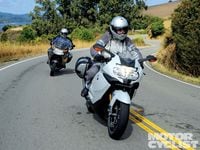



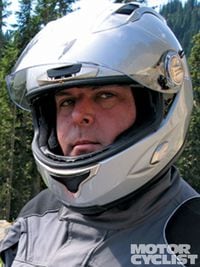
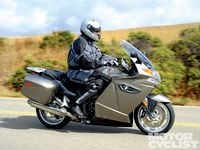

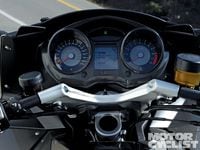
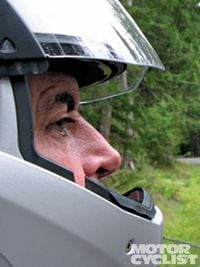


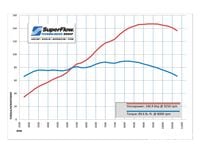

/cloudfront-us-east-1.images.arcpublishing.com/octane/QCZEPHQAMRHZPLHTDJBIJVWL3M.jpg)
/cloudfront-us-east-1.images.arcpublishing.com/octane/HXOUJXQWA5HBHGRO3EMJIGFMVI.jpg)

/cloudfront-us-east-1.images.arcpublishing.com/octane/3TIWWRV4JBBOLDVGRYECVVTA7Y.jpg)
/cloudfront-us-east-1.images.arcpublishing.com/octane/KIX5O23D5NAIBGFXBN3327DKZU.jpg)
/cloudfront-us-east-1.images.arcpublishing.com/octane/7GJYDUIPXRGMTMQKN6ONYOLBOU.jpg)
/cloudfront-us-east-1.images.arcpublishing.com/octane/MUQLOVLL2ZDGFH25ILABNBXKTI.jpg)
/cloudfront-us-east-1.images.arcpublishing.com/octane/TNOU5DNE2BC57MFPMGN2EIDXAM.jpg)
/cloudfront-us-east-1.images.arcpublishing.com/octane/GTCXACQGJ5HAPDTGWUQKDEH44E.jpg)
/cloudfront-us-east-1.images.arcpublishing.com/octane/S35YGSEMEZB4BLTDJTSZPF4GLA.jpg)
/cloudfront-us-east-1.images.arcpublishing.com/octane/5UOT6HPX2JFMRJAX6EH45AR4MQ.jpg)
/cloudfront-us-east-1.images.arcpublishing.com/octane/OKWOJWAKP5EP3OACCRRWPCIX2Q.jpg)
/cloudfront-us-east-1.images.arcpublishing.com/octane/2WF3SCE3NFBQXLDNJM7KMXA45E.jpg)
/cloudfront-us-east-1.images.arcpublishing.com/octane/G4MG6OUCJNBSHIS2MVVOTPX65E.jpg)
/cloudfront-us-east-1.images.arcpublishing.com/octane/IIGGWFOTOJGB7DB6DGBXCCMTDY.jpg)
/cloudfront-us-east-1.images.arcpublishing.com/octane/QSTCM6AVEZA5JJBUXNIQ3DSOF4.jpg)
/cloudfront-us-east-1.images.arcpublishing.com/octane/U4I7G625B5DMLF2DVIJDFZVV6M.jpg)
/cloudfront-us-east-1.images.arcpublishing.com/octane/B6XD6LS6IVCQPIU6HXDJSM3FHY.jpg)
/cloudfront-us-east-1.images.arcpublishing.com/octane/ICL63FEDDRDTTMINYICCEYGMDA.jpg)
/cloudfront-us-east-1.images.arcpublishing.com/octane/FCGZHQXRBZFLBAPC5SDIQLVF4I.jpg)
/cloudfront-us-east-1.images.arcpublishing.com/octane/WNOB6LDOIFFHJKPSVIWDYUGOPM.jpg)

/cloudfront-us-east-1.images.arcpublishing.com/octane/X33NU3E525ECRHXLNUJN2FTRKI.jpg)
/cloudfront-us-east-1.images.arcpublishing.com/octane/6KKT5NNL2JAVBOXMZYS5ZO76YA.jpg)